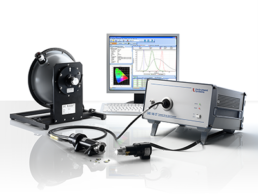What is the difference between radiometers, spectrometers, and spectroradiometers?
Radiometers
Radiometers measure the amount of electromagnetic energy present within a specific wavelength range. The measurement is expressed in Watts (W) which is a unit of measurement for power. Radiometers are usually used to detect and measure the amount of energy outside the visible light spectrum and are used to measure ultraviolet (UV) light or infrared (IR). A typical use for a UV meter is in the museum lighting world where the presence of UV is can be very troublesome. UV energy hastens the ageing process due to its higher energy content so any energy below 400nm needs to be filtered out or eliminated. Another application for a radiometer is in the detection and measurement of infrared or IR. It is used to detect and measure heat on a surface. Technicians use them to safely detect and repair overheating motors or shorted out wiring. Radiometers can measure very quickly because they are simple meters that use only one sensor with a filter designed to just measure the wavelength range they were intended for.
Spectrometers
Spectrometers, like radiometers, are instruments that measure a specific wavelength range. The biggest difference is spectrometers use an optical grating or prism and multiple sensors to break down the incoming energy into different wavelengths or components. Spectrometers are not complete instruments and need to be paired with optics in order to work correctly. It can be used with a camera system to measure watts per square meter SR nm (W/m2*SR*nm) or with a cosine corrected head to measure irradiance and report watts per square meter nm (W / m2 * nm). Spectrometers can have up to 2048 sensors so they are highly analytical and can give very precise data and can measure very accurately. And since they are not complete systems, they can be adapted and used in multiple industries and applications.
Spectroradiometers
A spectroradiometer is designed measure with precision radiance, luminance and chromaticity. It has a built-in optical measuring and targeting system measuring light from approximately 380nm to 780nm. Due to its high accuracy it is often used as a reference instrument in research and development laboratories. Other applications include being employed in an automated display characterization system where all aspects of a display are measured including viewing angles, gamma and contrast ratios. The biggest advantage to using a spectroradiometer is that they are completely standalone systems that work independently without the need to be connected to a PC. Spectroradiometers are ideal for use in the field where accurate measurements need to be taken under real world conditions. The optical design and signal processing technologies of the Konica Minolta CS-3000 instrument provides precise measurements of a light source or display’s chromaticity as well providing accurate measurement data for extremely low luminance levels. Measurements are calculated in as little as 5 seconds.
To measure light radiation’s spectral characteristics, Instrument Systems optical spectroradiometers are the instruments of choice. Instrument Systems has a variety of optical spectroradiometers to meet any user’s application needs or budget. Our CAS series includes our popular CAS120 & CAS 140 series of array spectroradiometers.
As you can see, though they have similar sounding names, the difference between spectrometers, radiometers and spectroradiometers can vary widely. Radiometers are inexpensive, portable and provide quick measurements while spectrometers are more accurate, modular, and may be used in different applications and settings. Finally, spectroradiometers offer the best of both worlds where you have the accuracy and portability that a specific application may require. For more information about radiometers, spectrometers, and spectroradiometers, give visit us at https://sensing.konicaminolta.us/us/technologies/#lightanddisplay.










